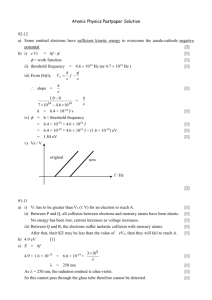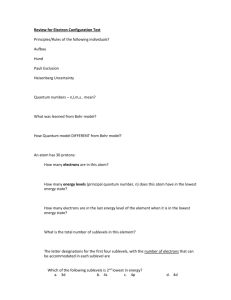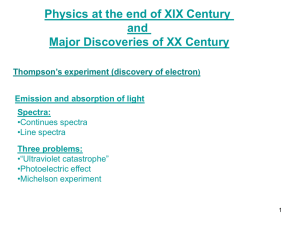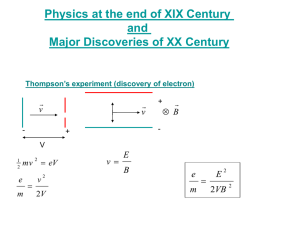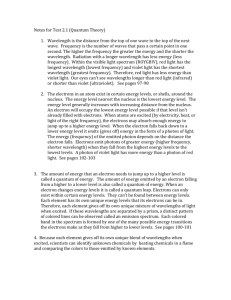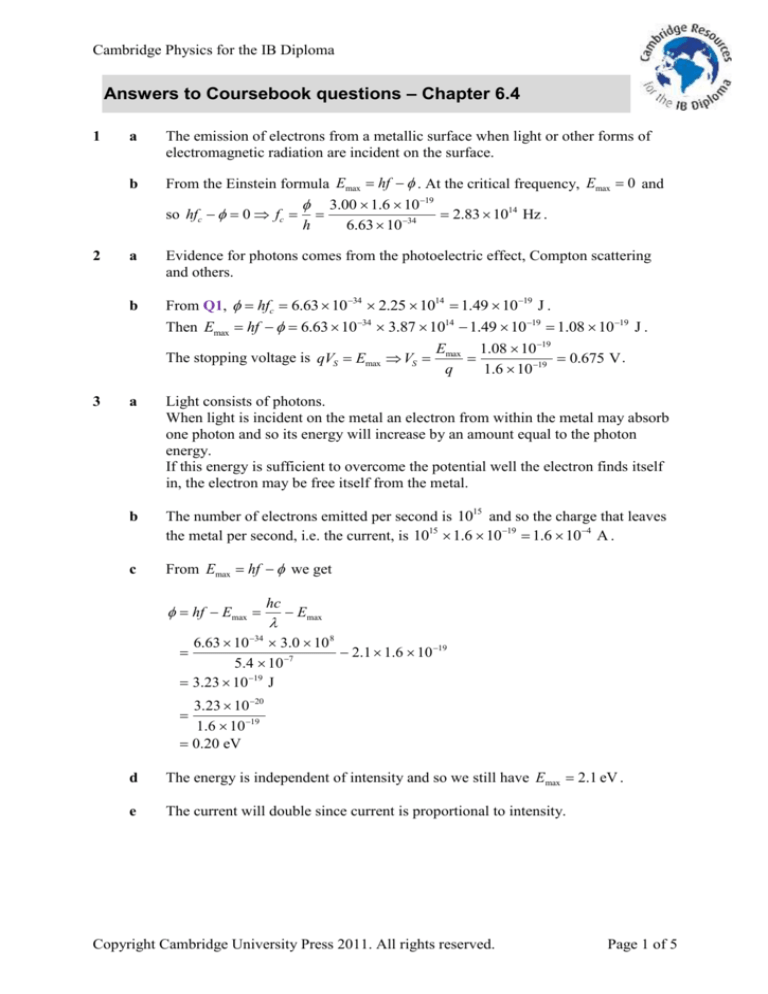
Cambridge Physics for the IB Diploma
Answers to Coursebook questions – Chapter 6.4
1
a
The emission of electrons from a metallic surface when light or other forms of
electromagnetic radiation are incident on the surface.
b
From the Einstein formula Emax hf . At the critical frequency, Emax 0 and
so hfc 0 fc
2
h
3.00 1.6 10 19
2.83 1014 Hz .
6.63 10 34
a
Evidence for photons comes from the photoelectric effect, Compton scattering
and others.
b
From Q1, hfc 6.63 1034 2.25 1014 1.49 1019 J .
Then Emax hf 6.63 1034 3.87 1014 1.49 1019 1.08 1019 J .
The stopping voltage is qVS Emax VS
3
Emax 1.08 1019
0.675 V .
q
1.6 10 19
a
Light consists of photons.
When light is incident on the metal an electron from within the metal may absorb
one photon and so its energy will increase by an amount equal to the photon
energy.
If this energy is sufficient to overcome the potential well the electron finds itself
in, the electron may be free itself from the metal.
b
The number of electrons emitted per second is 1015 and so the charge that leaves
the metal per second, i.e. the current, is 1015 1.6 1019 1.6 104 A .
c
From Emax hf we get
hf Emax
hc
Emax
6.63 10 34 3.0 10 8
2.1 1.6 10 19
7
5.4 10
3.23 10 19 J
3.23 10 20
1.6 10 19
0.20 eV
d
The energy is independent of intensity and so we still have Emax 2.1 eV .
e
The current will double since current is proportional to intensity.
Copyright Cambridge University Press 2011. All rights reserved.
Page 1 of 5
Cambridge Physics for the IB Diploma
4
a
The electrons are emitted without delay. In the photon theory of light the
energy is supplied to an electron by a single photon in an instantaneous
interaction.
There is a critical frequency below which no electrons are emitted. The energy of
the photon depends on frequency, so if the photon energy is less than the work
function the electron cannot be emitted.
The intensity of light has no effect on the energy of the emitted electrons. The
intensity of light depends on the number of photons present and so this will affect
the number of electrons emitted, not their energy.
b
qVS
hc
hc
qVS
Emax
q
34
6.63 10 3.0 108
1.6 1019 1.40 7.32 1019 J
7
2.08 10
The longest wavelength corresponds to the smallest frequency, i.e. the critical
frequency:
6.63 1034 3.0 108
0 C
2.7 107 m .
19
C
7.32 10
hc
5
6
hc
a
Increasing the intensity of light increases the number of electrons emitted, i.e. the
photocurrent. It has no influence on the energy of the emitted electrons.
b
We have that qVS
a
The work function is 3.0 1.6 10 19 4.8 10 19 J .
The power incident on the given area is
P 5.0 104 1.0 1018 5.0 1022 W .
To accumulate the energy equal to the work function we need a time of
4.8 10 19
960 s or 16 minutes.
5.0 1022 t 4.8 1019 , i.e. t
5.0 10 22
b
Since in photoelectric experiments there is no time delay in the emission of
electrons, light cannot be treated as a wave as this calculation has.
c
In the photon theory of light, the energy carried by a photon is given to the
electron in one go, not gradually.
hc
hc
and q(2VS )
.
7
2.3 10
1.8 107
hc
hc
Subtracting, qVS
VS 1.50 V .
7
1.8 10
2.3 107
hc
6.25 1019
19
qVS 6.25 10 J
3.9 eV .
Hence,
2.3 107
1.6 1019
Copyright Cambridge University Press 2011. All rights reserved.
Page 2 of 5
Cambridge Physics for the IB Diploma
7
8
9
a
Extending the graph, we find a horizontal intercept of about
5.0 1014 Hz .
b
The work function and the critical frequency are related through:
hfC 0 hfC 6.63 1034 5.0 1014 3.3 1019 J 2.1 eV .
c
Reading off the graph we find about 2.0 10 19 J 1.25 eV .
d
It will be a line parallel to the original with a horizontal intercept at
6.0 1014 Hz .
a
b
No, because to show diffraction effects, the brick would have to go through
openings of size similar to the wavelength, and this is not possible.
a
The Davisson–Germer experiment (see page 395 in Physics for the IB Diploma).
b
10
a
h 6.63 1034
2.7 1034 m .
p 0.250 10
6.63 10 34
9.75 10 28 Ns .
9
680 10
p 9.75 10 28
1.1 10 3 m s1 .
Hence v
31
m
9.1 10
p
h
The kinetic energy of the electron will be EK qV and so
p2
qV p 2mqV .
2m
h
h
Then
.
p
2mqV
h
2mp qpV
mα qα
4 2 8 .
h
mp qp
2mα qαV
b
p
α
c
p2
From EK
we find
2m
p 2mEK 2 9.1 10 31 520 1.6 10 19 1.23 10 23 N s .
h 6.63 1034
Hence
5.4 1011 m .
23
p 1.23 10
Copyright Cambridge University Press 2011. All rights reserved.
Page 3 of 5
Cambridge Physics for the IB Diploma
11
a
The intensity is I
P nhf
, where n is the number of photons incident
A
A
per second.
Then I hf , where
b
c
n
is the number of photons per second per unit area.
A
3.8 1018 6.63 10 34 3.0 10 8
I hf
1.5 Wm 2 .
7
5.0 10
hc
hc
hc
4.0 10 7
3.0 1018 m 2s1 .
5.0 10 7
d
Since the intensity is the same, the flux for the shorter wavelength is less and
hence fewer electrons will be emitted since fewer photons are incident.
e
This assumes that the fraction of photons that eject electrons is the same for both
wavelengths. This fraction is called the quantum efficiency, which in general
does depend on wavelength in a complex way.
Copyright Cambridge University Press 2011. All rights reserved.
Page 4 of 5
Cambridge Physics for the IB Diploma
Additional problems
A1
a
Assume that a current I is established in a conductor of cross-sectional
area A and that there are n free electrons per unit volume of the conductor.
Show that the current in the conductor is given by the expression I neAv ,
where v is the drift velocity of the electrons.
b
Photons are incident on a photosurface of area A and electrons are emitted from
the surface at a rate of r electrons per unit area per unit time.
Show that the current leaving the photosurface is I rAe .
c
More energetic photons are now incident on the photosurface at the same rate as
in b and so the emitted electrons have a greater speed. By reference to the results
in a and b discuss the effect of the greater electron speed on the photocurrent.
Solution
a
In 1 second the number of electrons that will go past a cross-sectional area of the
conductor is 1 nAv and so the charge per unit time crossing this area, i.e. the
current, is I neAv .
b
Since
we have r electrons per unit area per unit time, the number of electrons
leaving an area A per unit time is rA and hence the charge they carry per unit
time, i.e. the current, is I erA .
c
According to I = erA speed
should play no role but according to I = neAv it looks
like speed doesplay a role!
In time dt the number of emitted electrons from an area A is rAdt.
These electrons are confined within a cylinder of cross-sectional area A and
height vdt. Therefore the electron number density is n
rAdt r
Avdt v .
r
v
Substituting in the current formula, I nevA evA reA just as in b, so speed
plays no role.
Copyright Cambridge University Press 2011. All rights reserved.
Page 5 of 5

